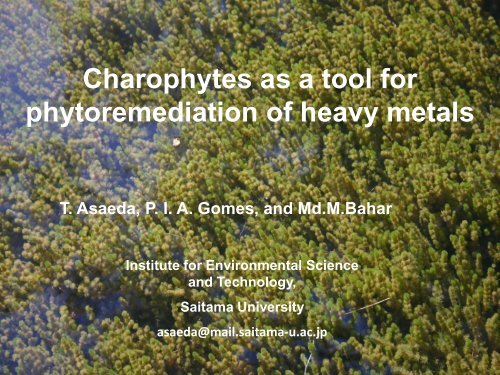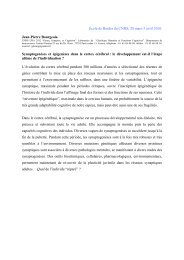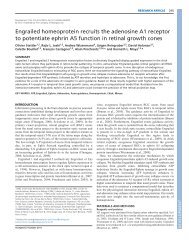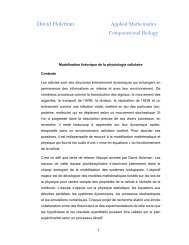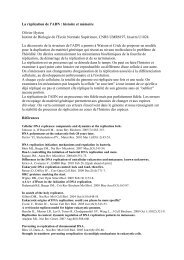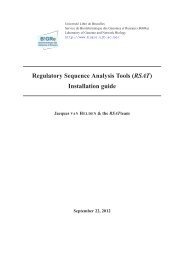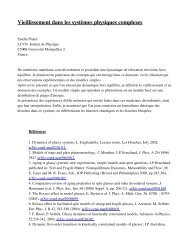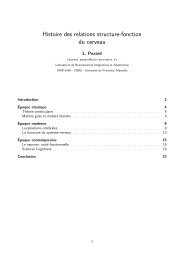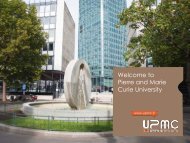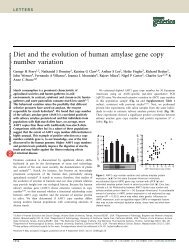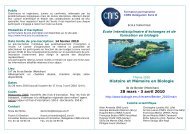Calcification of charaEffect of calcium encrustation on hevay metal ...
Calcification of charaEffect of calcium encrustation on hevay metal ...
Calcification of charaEffect of calcium encrustation on hevay metal ...
- No tags were found...
Create successful ePaper yourself
Turn your PDF publications into a flip-book with our unique Google optimized e-Paper software.
Charophytes as a tool forphytoremediati<strong>on</strong> <str<strong>on</strong>g>of</str<strong>on</strong>g> heavy <strong>metal</strong>sT. Asaeda, P. I. A. Gomes, and Md.M.BaharInstitute for Envir<strong>on</strong>mental Scienceand Technology,Saitama Universityasaeda@mail.saitama-u.ac.jp1
Charophytes• They are <strong>on</strong>e <str<strong>on</strong>g>of</str<strong>on</strong>g> the closestrelatives <str<strong>on</strong>g>of</str<strong>on</strong>g> terrestrial plants• They attach <strong>on</strong> the bottom byrhizoids• They reproduce both asexuallyand sexually. (bulbils & oosporesmainly)• Propagule bank c<strong>on</strong>sists <str<strong>on</strong>g>of</str<strong>on</strong>g>oospores (perennial) and bulbils• There are six genera; Chara,Nitella, Lamprothamnium,Tolypella, Lychnothamnus andNitellopsis.Charophytes with sexualorgans
Ecological significance <str<strong>on</strong>g>of</str<strong>on</strong>g> CharophytesNutrientslow bioturbati<strong>on</strong>velocity distributi<strong>on</strong>settling <str<strong>on</strong>g>of</str<strong>on</strong>g> SSCharophytesdead plantsrefuge for zooplankt<strong>on</strong>mechanically stablegyttjastabley stockedlow re-suspensi<strong>on</strong>• They do not allow materials to besuspended easily.• They are slowly decomposed andstably accumulated <strong>on</strong> the bottom• They provide habitats for variousorganisms particularly for zooplankt<strong>on</strong>
Charophytes are intensively calcified in Ca rich water• CaCO 3 incrustati<strong>on</strong> occurs in stems,branchlets, surface <str<strong>on</strong>g>of</str<strong>on</strong>g> oog<strong>on</strong>ia• CaCO 3 amounts up to 50-60% dry wt(Van den Berg et al 2002)• Generally Chara spp is more calcifiedthan Nitella spp (Imahori 1954)Calcified chara. spp
Calcite Encrustati<strong>on</strong> (based <strong>on</strong> McC<strong>on</strong>naughey’s Model)photosynthesisMcC<strong>on</strong>naughey (1991 ). Limnol. Oceanogr. 36:619–628.
Highly calcified Chara6
Objective and HypothesisGeneral objective:• to reduce heavy <strong>metal</strong>s in water using the calcificati<strong>on</strong> process <str<strong>on</strong>g>of</str<strong>on</strong>g> charophytes.Background:• Phytochelatins (PCs) and <strong>metal</strong>lothi<strong>on</strong>eins (MTs) are the processes by whichplant cell detoxify heavy <strong>metal</strong>s (Cobbett and Goldsbrough 2002)• Phosphorus is co-precipitated with charophyte calcite even in very lowphosphorus (Si<strong>on</strong>g and Asaeda 2006)Hypothesis• Charophytes are likely relatively tolerant to heavy <strong>metal</strong>s..• The co-precipitati<strong>on</strong> process is not selective, thus, heavy <strong>metal</strong>s can also beco-precipitated (or adsorbed) with the calcite.
Hypothesis <str<strong>on</strong>g>of</str<strong>on</strong>g> Co-precipitati<strong>on</strong> <str<strong>on</strong>g>of</str<strong>on</strong>g> heavy <strong>metal</strong> with Calcitephotosynthesisheavy <strong>metal</strong>heavy <strong>metal</strong>McC<strong>on</strong>naughey (1991 ). Limnol. Oceanogr. 36:619–628.8
We questi<strong>on</strong>ed:• Are charophytes lively in Ca rich water?• How tolerant are charophytes to heavy <strong>metal</strong>s?• Are heavy <strong>metal</strong>s stably co-precipitated?9
How lively are charophytes in Ca rich water?10
Growth measurementsa 1a 3• Lengths for primary, and sub divisi<strong>on</strong>s were recorded separately• Total length was used for analysis (L t =a 1 +a 2 +a 3 +b 1 )Growth rate ~ el<strong>on</strong>gati<strong>on</strong> rate = (L t -L 0 ) x 100/ L 0 (%)a 2b 1Flurocam images were used forCorrecti<strong>on</strong> <str<strong>on</strong>g>of</str<strong>on</strong>g> measurements• At the end <str<strong>on</strong>g>of</str<strong>on</strong>g> experiments relevant plants werephotographed using Flurocamlength measurement correcti<strong>on</strong>11
el<strong>on</strong>gati<strong>on</strong> ratewith respect to the initial length (%)el<strong>on</strong>gati<strong>on</strong> ratewith respecto to the initial length (%)1009080706050403020100Ca 4mg/lCa 40mg/lCa 80mg/lCa 120mg/l1 2 3 4 5 6weeksNitella pseud<str<strong>on</strong>g>of</str<strong>on</strong>g>rabellataThe growth rate was even largerin the higher Ca c<strong>on</strong>centrati<strong>on</strong>450400350300250200150100500Effect <str<strong>on</strong>g>of</str<strong>on</strong>g> Ca c<strong>on</strong>centrati<strong>on</strong><strong>on</strong> the growth <str<strong>on</strong>g>of</str<strong>on</strong>g> CharophytesChara fibrosaCa 4mg/lCa 40mg/lCa 80mg/l0 1 2 3 4 5 6 7 8 9weeks
How are charophytes tolerant to heavy <strong>metal</strong>s?
Materials and methodsMaterials: Nitella pseud<str<strong>on</strong>g>of</str<strong>on</strong>g>labellataIncubated at 12hr:12hr (light: dark) , 24 o C.Ca c<strong>on</strong>centrati<strong>on</strong> (CaCl 2 .2H 2 0 ):4mg/l, 40mg/l, 80mg/lAfter 4 weeks,C 412 11 10 9Low Cr (VI) High Cr (VI)C 408 7 6 54 3 2 1C 800.0 0.1 0.2 0.4 0.844080Ca c<strong>on</strong>centrati<strong>on</strong> mg/LCr(VI) was added by K 2 Cr 2 0 7with c<strong>on</strong>centrati<strong>on</strong>s,c<strong>on</strong>trol, 0.1mg/l, 0.2mg/l, 0.4mg/l, 0.8mg/lThe el<strong>on</strong>gati<strong>on</strong> was measured every week, andthe maximum quantum efficiency <str<strong>on</strong>g>of</str<strong>on</strong>g> PSIIphotochemistry was measured.Cr (VI) c<strong>on</strong>centrati<strong>on</strong> mg/L
el<strong>on</strong>gati<strong>on</strong> ratewith respect to the initial length (%)el<strong>on</strong>gati<strong>on</strong> ratewith respect to the initial length (%)el<strong>on</strong>gati<strong>on</strong> ratewith respect to the initial length (%)350300250200Ca: 4mg/lc<strong>on</strong>trol0.1mgCr(IV)/l0.2mgCr(VI)/l0.4mgCr(IV)/l0.8mgCr(IV)/l350300250200Ca:40mg/lc<strong>on</strong>trol0.1mgCr(VI)/l0.2mgCr(VI)/l0.4mgCr(VI)/l0.8mgCr(VI)/l15015010010050Cr(VI) added50Cr(VI) added00 1 2 3 4 5 6 7 8 9weeks00 1 2 3 4 5 6 7 8 9weeksEl<strong>on</strong>gati<strong>on</strong> rate <str<strong>on</strong>g>of</str<strong>on</strong>g> charophytesin different Cr (VI) c<strong>on</strong>centrati<strong>on</strong> mediaCr (VI) is added after 4 th weekTolerance to heavy <strong>metal</strong> (Cr)toxicity has the positivecorrelati<strong>on</strong> with Ca inwater/calcificati<strong>on</strong>.45040035030025020015010050Ca:80mg/lc<strong>on</strong>trol0.1mgCr(VI)/l0.2mgtCr(VI)/l0.4mgCr(VI)/l0.8mgCr(VI)/lCr(VI) added00 1 2 3 4 5 6 7 8 9weeks
Maximum quantum efficiency <str<strong>on</strong>g>of</str<strong>on</strong>g> PSII photochemistry (F v /F m )Cr(VI) c<strong>on</strong>centrati<strong>on</strong>F v /F m0.8 0.39-0.440.4 0.40-0.630.2 0.72-0.760.1 0.77-0.79Fv/Fm values before Cr (VI) additi<strong>on</strong> did not showsignificant difference (t-test, P< 0.05)Stress free plants show Fv/Fm greater than 0.8 (DeEll and Toiv<strong>on</strong>en, 2003; Maxwelland Johns<strong>on</strong> 2000). ・・・more affected with increasing Cr c<strong>on</strong>centrati<strong>on</strong>Charophytes have satisfactory tolerance to Cr(VI).
How stably are heavy <strong>metal</strong>s co-precipitated?
Materials:Cara fibrosa Agrardh ex Bruzelius vs CdIncubati<strong>on</strong> c<strong>on</strong>diti<strong>on</strong>:2h:12h (light (40mmol/m 2 s -1 ): dark) for 1.5 m<strong>on</strong>thpH:7.0±0.1; Ca: 17±2 mg/L; Mg: 4±1 mg/L; SRP 5±1 mgP/LNO 3- : 1.1±0.2 mgN/L; SO 42-: 35±3 mg/L;Total alkalinity: 33±3 mg CaCO3/LCd c<strong>on</strong>centrati<strong>on</strong>:C<strong>on</strong>trol (mg Cd/L), 0.001 mg Cd/L, 0.01mg Cd/L, 0.1mg Cd/LFor comparis<strong>on</strong>,Attached algae (Oscillatoria spp.) were incubated with 0.01 mg Cd/L
Chemical analysessample• Dissolved in 1.0mol/L HNO 3• Cd and Ca were measurer by double-beam atomic absorpti<strong>on</strong> spectrophotometerSequential fracti<strong>on</strong>ati<strong>on</strong>:• extracti<strong>on</strong> exchangeable fracti<strong>on</strong> with magnesium chloride (MgCl 2 , pH 7.0)• carb<strong>on</strong>ate-bound fracti<strong>on</strong> with sodium acetate (NaOAc, pH 5.0)• organic fracti<strong>on</strong> with H 2 O 2 and HNO 3
Chemical AnalysisSequentialFracti<strong>on</strong>ati<strong>on</strong>20-40 mg sample10 mL <str<strong>on</strong>g>of</str<strong>on</strong>g> 1.0 mol L -1MgCl 2(pH 7.0): 30 minSample0.1 g sample,dry-ashing 400 o C, 20 hTotal Ca and CdExtractExchangeable -Fracti<strong>on</strong>Residue10 mL NaOAc 1.0mol L -1(pH 5.0); 5 h50 mL HNO 31 mol L -1 filteredResidueExtractExtractCarb<strong>on</strong>ate -bound Fracti<strong>on</strong>extractResidue5 mL HNO 335% + 5 mLH 2O 230%, 85 o C, 5mL + 20 distilled water 25 mL, filteredResidue(discharged)Atomic Absorpti<strong>on</strong>Spectrophotometer-Graphite furnace(GFAA)Total MetalsOrganic-boundFracti<strong>on</strong>
Cd in media (mg/L) : 0.001 Cd: 0.01 mg/L Cd: 0.1 mg/LTotal Cd in plant: 0.3 mg/kg dryweight basis (d.w.),BCF (bio-c<strong>on</strong>centrati<strong>on</strong> factor) :300Total Cd: 125-134 mg/kg d.w.BCF: 12500 - 13400Total Cd: 734 mg/kg d.w.BCF: 7340
fracti<strong>on</strong> (%)Total Ca (mg/g dry weight)30025020015010050Ca c<strong>on</strong>tent was not muchaffected by Cd c<strong>on</strong>centrati<strong>on</strong>,more affected by age.(alkaline z<strong>on</strong>e extends with age)0c<strong>on</strong>trolmature0.001mg/L Cdyoung0.01mg/L Cdmature0.1mg/L Cdmaureepiphytes0.01mg/L Cd1009080706050403020100c<strong>on</strong>trolmature0.001mg/L Cdyoung0.01mg/L Cdmature0.1mg/L Cdmaureepiphytes0.01mg/L CdWith increasing Cd c<strong>on</strong>centrati<strong>on</strong>,the fracti<strong>on</strong> <str<strong>on</strong>g>of</str<strong>on</strong>g> carb<strong>on</strong>ate-bound Ca increases.Most <str<strong>on</strong>g>of</str<strong>on</strong>g> Ca was exchangeable for epiphytic algae.Organic-bound Ca Carb<strong>on</strong>ate-bound Ca exchangeable Ca (%)
fracti<strong>on</strong> (%)Total Cd (mg/Kg dry weight)10009008007006005004003002001000c<strong>on</strong>trolmature0.001mg/L Cdyoung0.01mg/L Cdmature0.1mg/L Cdmaureepiphytes0.01mg/L CdTotal Cd c<strong>on</strong>tent increaseswith Cd c<strong>on</strong>centrati<strong>on</strong>1009080706050403020100c<strong>on</strong>trolmature0.001mg/L Cdyoung0.01mg/L Cdmature0.1mg/L Cdmaureepiphytes0.01mg/L CdOrganic-bound Cd Carb<strong>on</strong>ate-bound Cd exchangeable CdThe fracti<strong>on</strong> <str<strong>on</strong>g>of</str<strong>on</strong>g> carb<strong>on</strong>ate-bound Cd increases with Cd c<strong>on</strong>centrati<strong>on</strong>.Cd <str<strong>on</strong>g>of</str<strong>on</strong>g> epiphytic algae is mostly exchangeable.
Major comp<strong>on</strong>ents <str<strong>on</strong>g>of</str<strong>on</strong>g> <str<strong>on</strong>g>calcium</str<strong>on</strong>g> and cadmium <strong>on</strong> the cell surface <str<strong>on</strong>g>of</str<strong>on</strong>g> Charathe results <str<strong>on</strong>g>of</str<strong>on</strong>g> visual Minteq (Gustafs<strong>on</strong>, 2007)Input data Ca: 17mg/l, Mg: 4mg/l, PO 43-: 5mgP/l, NO 3- : 1.1mgN/l, SO 42-:35mg/l,Total alkalinity: 33mgCaCO 3 /l, temperature 25 o CMedium (mgCd/l)0.0010.01-0.1under illuminati<strong>on</strong>Acidic (pH 5.5-6.1) Alkaline (pH 8.0-9.6)Ca 2+ CaSO 4 (aq) Ca 2+ CaCO 3(aq) CaSO 4(aq) Ca 2+ CaSO 4 (aq)Cd 2+ CdSO 4 (aq) Cd 2+ CdSO 4(aq) CdHCO 3+CdCO 3(aq) Cd(CO 3 ) 2 2- Cd 2+ CdSO 4 (aq)Ca 2+ CaSO 4 (aq) Ca 2+ CaCO 3(aq) CaSO 4(aq) Ca 2+ CaSO 4 (aq)Cd 2+ CdSO 4 (aq) Cd 2+ CdSO 4(aq) CdHCO 3+darkness(pH 6.0-7.2)CdCO 3(aq) Cd(CO 3 ) 2 2- Cd 2+ CdSO 4 (aq)Red : oversaturated > precipitatedCa CalciteCd OtaviteCalcite was oversaturated over pH=8.3CdCO 3 was oversaturated at pH=8.5-9.4( 0.01mgCD/l), 7.9-9.9 (0.1mgCd/l)CaCO 3 and CdCO 3were precipitated simultaneously. In the alkaline z<strong>on</strong>e.
Alkaline band(calcified)Acidic band(n<strong>on</strong>calcified)Calcified Otavite = alkaline layer <strong>on</strong> the calcite <strong>on</strong>ly slowlydissolved.Carb<strong>on</strong>ate-bound Cd is not affectedby anoxic c<strong>on</strong>diti<strong>on</strong>.The extensi<strong>on</strong> <str<strong>on</strong>g>of</str<strong>on</strong>g> alkaline bandwith age cause the precipitati<strong>on</strong> <str<strong>on</strong>g>of</str<strong>on</strong>g>otavite encrusted with calcite.
heavy <strong>metal</strong>sNutrientslow bioturbati<strong>on</strong>settling <str<strong>on</strong>g>of</str<strong>on</strong>g> SSvelocity distributi<strong>on</strong>Charophytesgyttjamechanically stabledead plantsstabley co-precipitatedand accumulatedrefuge for zooplankt<strong>on</strong>low re-suspensi<strong>on</strong>
C<strong>on</strong>clusi<strong>on</strong>sPossible usage <str<strong>on</strong>g>of</str<strong>on</strong>g> calcificati<strong>on</strong> <str<strong>on</strong>g>of</str<strong>on</strong>g> carophytes for the trap <str<strong>on</strong>g>of</str<strong>on</strong>g> heavy <strong>metal</strong>s wereinvestigated.• Charophytes preferably grow in high c<strong>on</strong>centrati<strong>on</strong> <str<strong>on</strong>g>of</str<strong>on</strong>g> Ca 2+ in the media.• Although the growth is more affected with increasing c<strong>on</strong>centrati<strong>on</strong>,charophytes still have satisfactory tolerance against heavy <strong>metal</strong>s andaccumulate them.• Heavy <strong>metal</strong>s are co-precipitated by the <str<strong>on</strong>g>calcium</str<strong>on</strong>g> carb<strong>on</strong>ate <str<strong>on</strong>g>encrustati<strong>on</strong></str<strong>on</strong>g>,are stably trapped.Therefore, charophytes become a feasible media to trap heavy <strong>metal</strong>s in water.27
Thank you for your attenti<strong>on</strong>28
fracti<strong>on</strong> (%)1009080706050403020100CaCO3-Cd CaCO3-Cdco-precipitated co-precipitatedas ani<strong>on</strong> as cati<strong>on</strong>CommercialCaCO 3Cd adsorbedby calciteOtavite layer <strong>on</strong> the calcite <strong>on</strong>ly slowlydissolved.Carb<strong>on</strong>ate-bound Cd is not affectedby anoxic c<strong>on</strong>diti<strong>on</strong>.Organic-bound CdExchangeable CdCarb<strong>on</strong>ate-bound Cd29
alkaline regi<strong>on</strong>acid regi<strong>on</strong><str<strong>on</strong>g>Calcificati<strong>on</strong></str<strong>on</strong>g> model (Borowitzka, 1982)medium cell wall cellHCO 3-HCO 3-OH - + CO 2HCO 3- + OH -OH -H 2 O + CO 32-Ca 2+ C a CO 330
Calcified = alkalineUncalcified =acidCalcified = alkalineUncalcified = acidCalcified = alkaline31


